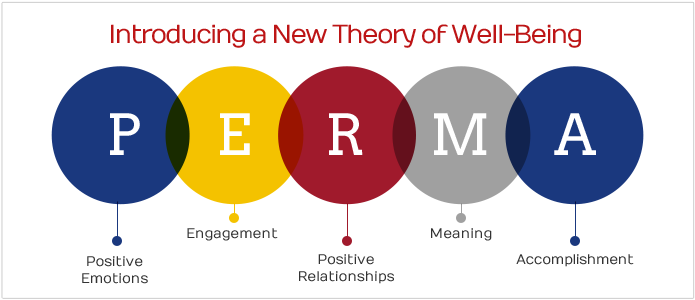TED 2004: The new era of positive psychology | Martin Seligman - YouTube
Martin Seligman - Wikipedia
Authentic Happiness | Authentic Happiness
Foundations of Positive Psychology | Coursera
$79 USD per month, includes certificate, or "audit" (watch only) for free
University of Pennsylvania
- Positive Psychology: Martin E.P. Seligman’s Visionary Science with Dr. Martin E.P. Seligman
- Jun 26 — Jul 31
- Positive Psychology: Applications and Interventions with Dr. James Pawelski
- Positive Psychology: Character, Grit and Research Methods with Dr. Angela Duckworth & Dr. Claire Robertson-Kraft
- Jun 26 — Jul 31
- Positive Psychology: Resilience Skills with Dr. Karen Reivich
- Positive Psychology Specialization Project with Dr. Martin E.P. Seligman
Psychology:
- reduce misery
- increase happiness
- "Pleasant" life (heritable, hard to change, easy to get used to)
- "Good" life (Engagement, Flow, time stops)
- "Meaningful" life

Authentic Happiness: Using the New Positive Psychology to Realize Your Potential for Lasting Fulfillment: Martin E. P. Seligman: 8601404545245: Amazon.com: Books
Authentic Happiness by Martin Seligman - YouTube
review by Brian Johnson
“…there is astonishing convergence across the millennia and across cultures about virtue and strength. Confucius, Aristotle, Aquinas, the Bushido samurai code, the Bhagavad-Gita, and other venerable traditions disagree on the details, but all of these codes include six core virtues:
- Wisdom and knowledge
- Courage
- Love and humanity
- Justice
- Temperance
- Spirituality and transcendence
Rather, I believe that the highest success in living and the deepest emotional satisfaction comes from building and using your signature strengths.”
Job => Career => Calling
"Know your strengths, use them often, you will be happier"

Learned Optimism: How to Change Your Mind and Your Life - Kindle edition by Martin E.P. Seligman. Religion & Spirituality Kindle eBooks @ Amazon.com.
Learned Optimism by Martin Seligman - YouTube
review by Brian Johnson
“Habits of thinking need not be forever. One of the most signi
in psychology in the last twenty years is that individuals can change how
they think.” - Martin Seligman
“Learned optimism is not a rediscovery of the ‘power of positive thinking.’ … Changing the
destructive things you say to yourself when you experience the setbacks that life deals all of us is
the central skill of optimism.”
“There are three crucial dimensions to your explanatory style:
- Permanence: Is it likely to continue? Is it permanent or temporary?
- Good: pessimist things is temporary, optimists things is permanent
- Bad: pessimist things is permanent, optimists things is temporary
- Pervasiveness: Is it reflective of your whole life? Is it “universal” or is it “specific”?
- Good: pessimist: fluke, optimists: universal
- Bad: pessimist: universal, optimists: fluke
- Personalization: Internal or external?
- Good: pessimist: external, optimists: internal
- Bad: pessimist: internal, optimists: external
“Unlike dieting, learned optimism is easy to maintain once you start. Once you get into the
habit of disputing negative beliefs, your daily life will run much better, and you will feel much
happier.”
Characteristics for job success:
- Aptitude
- Motivation
- Optimism
"Success requires persistence, the ability to not give up in the face of failure. I believe that
optimistic explanatory style is the key to persistence.” - Martin Seligman
What is Active and Constructive Responding? | GoStrengths!

Active & Constructive Responding - YouTube
by Dr. Martin Seligman
Active Constructive Responding - YouTube
Building Resilience by Martin E.P. Seligman @ HBR, 2011
Building the State of Wellbeing
- A Strategy for South Australia
- Professor Martin Seligman (PDF)
optimistic explanatory style is the key to persistence.” - Martin Seligman
What is Active and Constructive Responding? | GoStrengths!
Active & Constructive Responding - YouTube
by Dr. Martin Seligman
Active Constructive Responding - YouTube
Building Resilience by Martin E.P. Seligman @ HBR, 2011
Building the State of Wellbeing
- A Strategy for South Australia
- Professor Martin Seligman (PDF)
selective attention test - YouTube
www.theinvisiblegorilla.com
'Invisible Gorilla' Test Shows How Little We Notice
www.theinvisiblegorilla.com
'Invisible Gorilla' Test Shows How Little We Notice
Prospection: Psychology Turns to the Future - The Psychology of Wellbeing
Homo Prospectus: 9780199374472: Medicine & Health Science Books @ Amazon.com
Unleashing the Power: Anthony Robbins, Positive Psychology, and the Quest for Human Flourishing
Positive Thinking vs. Positive Psychology
Questionnaire Center | Authentic Happiness
Myers-Briggs or VIA Survey (Character Strengths)? | Psychology Today


